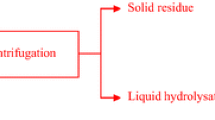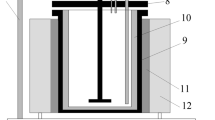Abstract
Proteins are the major organic component s of waste activated sludge (WAS); the recovery of sludge proteins is economically valuable. To efficiently recover sludge proteins, WAS should undergo hydrolysis pretreatment to fully release proteins from sludge flocs and microbial cells into aqueous phase. One of the most widely used chemical methods for that is thermal alkali hydrolysis (TAH). Here, the soluble protein concentration achieved the highest level over 90 min of TAH pretreatment at 80°C; the sludge floc disintegration and microbial cell destruction were maximized according to the content profiles of bound extracellular polymeric substance (EPS) and ribonucleic acid (RNA) of sludge. Both less proteins broken down to materials with small molecular weight and less melanoidin generated were responsible. TAH pretreatment at 80°C for 90 min resulted in the solubilization of 67.59% of sludge proteins. 34.64% of solubilized proteins was present in soluble high molecular; 1.55% and 4.85% broke down to polypeptides and amino acids. The lost proteins via being converted to ammonium and nitrate nitrogen accounted for 9.44% of solubilized proteins. It was important to understand the fate of sludge proteins during TAH pretreatment in terms of protein recovery, which would be helpful for designing the downstream protein separation method and its potential application.

Similar content being viewed by others
References
Ai S J, Liu H Y, Wu M J, Zeng G G, Yang C P (2018). Roles of acidproducing bacteria in anaerobic digestion of waste activated sludge. Frontiers of Environmental Science & Engineering, 12(6): 3
APHA (2005). Standard Methods for the Examination of Water and Wastewater (21st edition). Washington, D.C.: American Public Health Association, USA
Bohle B, Zwōlfer B, Heratizadeh A (2006). Cooking birch pollenrelated food: Divergent consequences for Ig E–and T cellmediated reactivity in vitro and in vivo. Journal of Allergy and Clinical Immunology, 118 (1): 242–249
Chen Y G, Jiang S, Yuan H Y, Zhou Q, Gu G W (2007). Hydrolysis and acidification of waste activated sludge at different pHs. Water Research, 41: 683–689
Chishti S S, Hasnain S N, Khan M A (1992). Studies on the recovery of sludge protein. Water Research, 26(2): 241–248
Cho S, Shin H, Kim D (2012). Waste activated sludge hydrolysis during ultrasonication: Two–step disintegration. Bioresource Technology, 121: 480–483
Duan Y Q, Zhou A J, Wen K L, Liu Z H, Liu W Z, Wang A J, Yue X P (2019). Upgrading VFAs bioproduction from waste activated sludge via co–fermentation with soy sauce residue. Frontiers of Environmental Science & Engineering, 13(1): 3
Dubois M, Gilles K A, Hamilton J K, Rebers P A, Smith F (1951). A colorimetric method for the determination of sugars. Nature, 28(7): 167–168
Dwyer J, Starrenburg D, Tait S, Barr K, Batstone D J, Lant P (2008). Decreasing activated sludge thermal hydrolysis temperature reduces product colour, without decreasing degradability. Water Research, 42 (18): 4699–4709
Ewa L B, Stanislaw L (2001). RNA assay as a method of viable biomass determination in the organic fraction of municipal solid waste suspension. Biotechnology Letters, 23: 1057–1060
Gao X, Liu N (2011). Determination of amino acid contents in the whole plant of Rumex dentatus by reversed–phase high–performance liquid chromatography with AccQ$Tag pre–column derivatization method. Food Science, 32(20): 160–163 (in Chinese)
Hamid H, Eskicioglu C (2013). Effect of microwave hydrolysis on transformation of steroidal hormones during anaerobic digestion of municipal sludge cake. Water Research, 47: 4966–4977
Huang X, Yu Z, Li C (2005). Advanced Biochemistry. Beijing: Chemical Industry Press
Hwang J, Zhang L, Seo S, Lee Y W, Jahng D (2008). Protein recovery from excess sludge for its use as animal feed. Bioresource Technology, 99: 8949–8954
Li Y Y, Noike T (1992). Upgrading of anaerobic–digestion of waste activated–sludge by thermal pretreatment. Water Science and Technology, 26(3–4): 857–866
Liu Y, Kong S, Li Y, Zeng H (2009). Novel technology for sewage sludge utilization: Preparation of amino acids chelated trace elements (AACTE) fertilizer. Journal of Hazardous Materials, 171(1–3): 1159–1167
Shier W T, Purwono S K (1994). Extraction of single–cell protein from activated sewage sludge: thermal solubilisation of protein. Bioresource Technology, 49: 157–162
Tanaka S, Kobayashi T, Kamiyama K, Bildan ML N S (1997). Effects of thermochemical pretreatment on the anaerobic digestion of waste activated sludge. Water Science and Technology, 35(8): 209–215
Wang X, Li Y, Liu J, Ren N, Qu J (2016). Augmentation of proteinderived acetic acid production by heat–alkaline–induced changes in protein structure and conformation. Water Research, 88: 595–603
Wilson C A, Novak J T (2009). Hydrolysis of macromolecular components of primary and secondary wastewater sludge by thermal hydrolytic pretreatment. Water Research, 43: 4489–4498
Xiao K, Chen Y, Jiang X, Seow W Y, He C, Yin Y, Zhou Y (2017). Comparison of different treatment methods for protein solubilisation from waste activated sludge. Water Research, 122: 492–502
Zagon J, Jansen B, Knoppik M (2010). Gene transcription analysis of carrot allergens by relative quantification with single and duplex reverse transcription real–time PCR. Analytical and Bioanalytical Chemistry, 396(1): 483–493
Zhang P, Zhang G, Wang W (2007). Ultrasonic treatment of biological sludge: Floc disintegration, cell lysis and inactivation. Bioresource Technology, 98: 207–210
Zhao J, Wang D, Li X, Yang Q, Chen H, Zhong Y, Zeng G (2015). Free nitrous acid serving as a pretreatment method for alkaline fermentation to enhance short–chain fatty acid production from waste activated sludge. Water Research, 78: 111–120
Acknowledgements
This research was supported by a grant from the Major Science and Technology Program for Water Pollution Control and Treatment of China (No. 2015ZX07306001-5) and the National Key Research and Development Program (No. 2016YFC0400707).
Author information
Authors and Affiliations
Corresponding author
Rights and permissions
About this article
Cite this article
Song, X., Shi, Z., Li, X. et al. Fate of proteins of waste activated sludge during thermal alkali pretreatment in terms of sludge protein recovery. Front. Environ. Sci. Eng. 13, 25 (2019). https://doi.org/10.1007/s11783-019-1114-7
Received:
Revised:
Accepted:
Published:
DOI: https://doi.org/10.1007/s11783-019-1114-7




